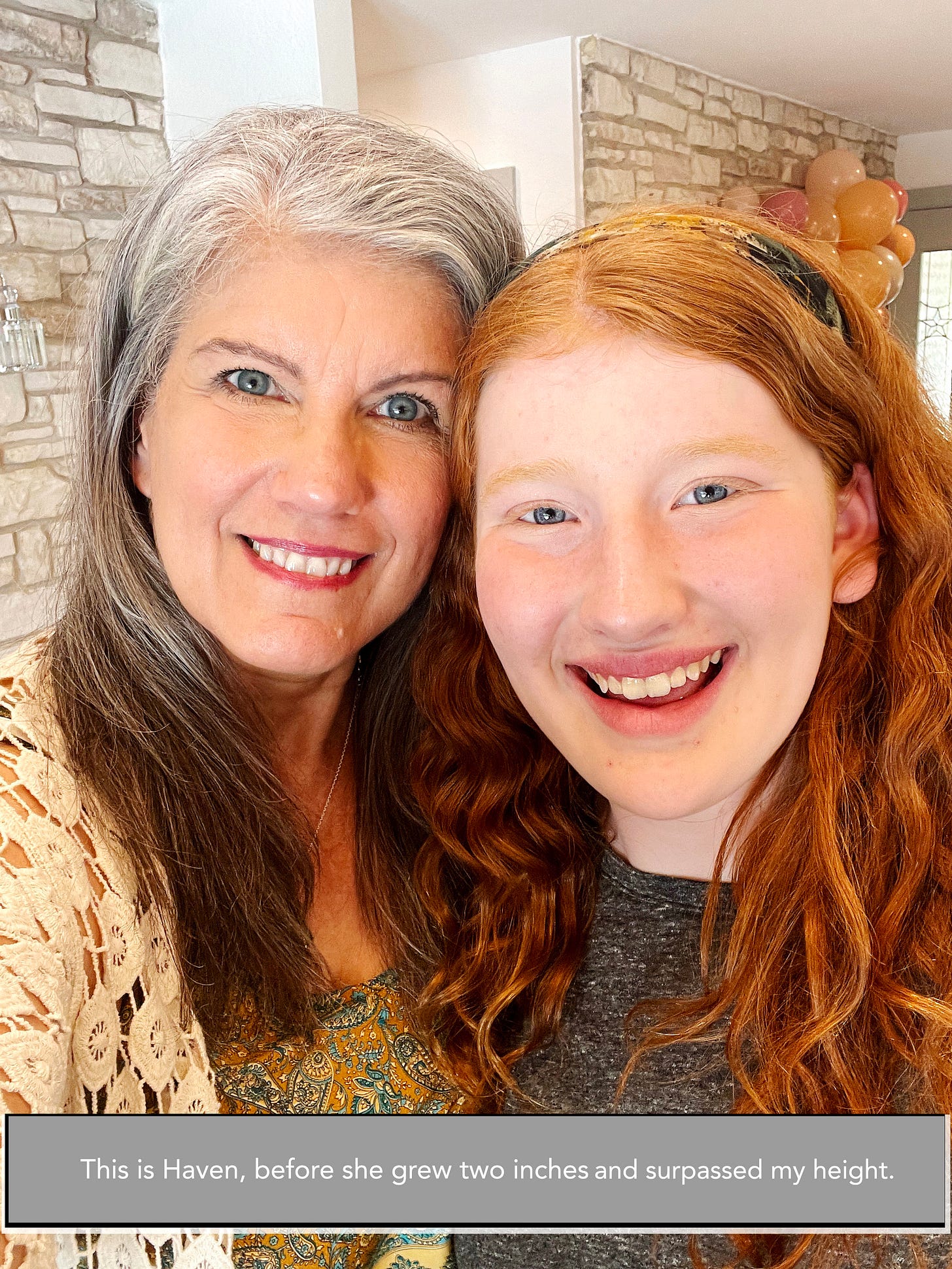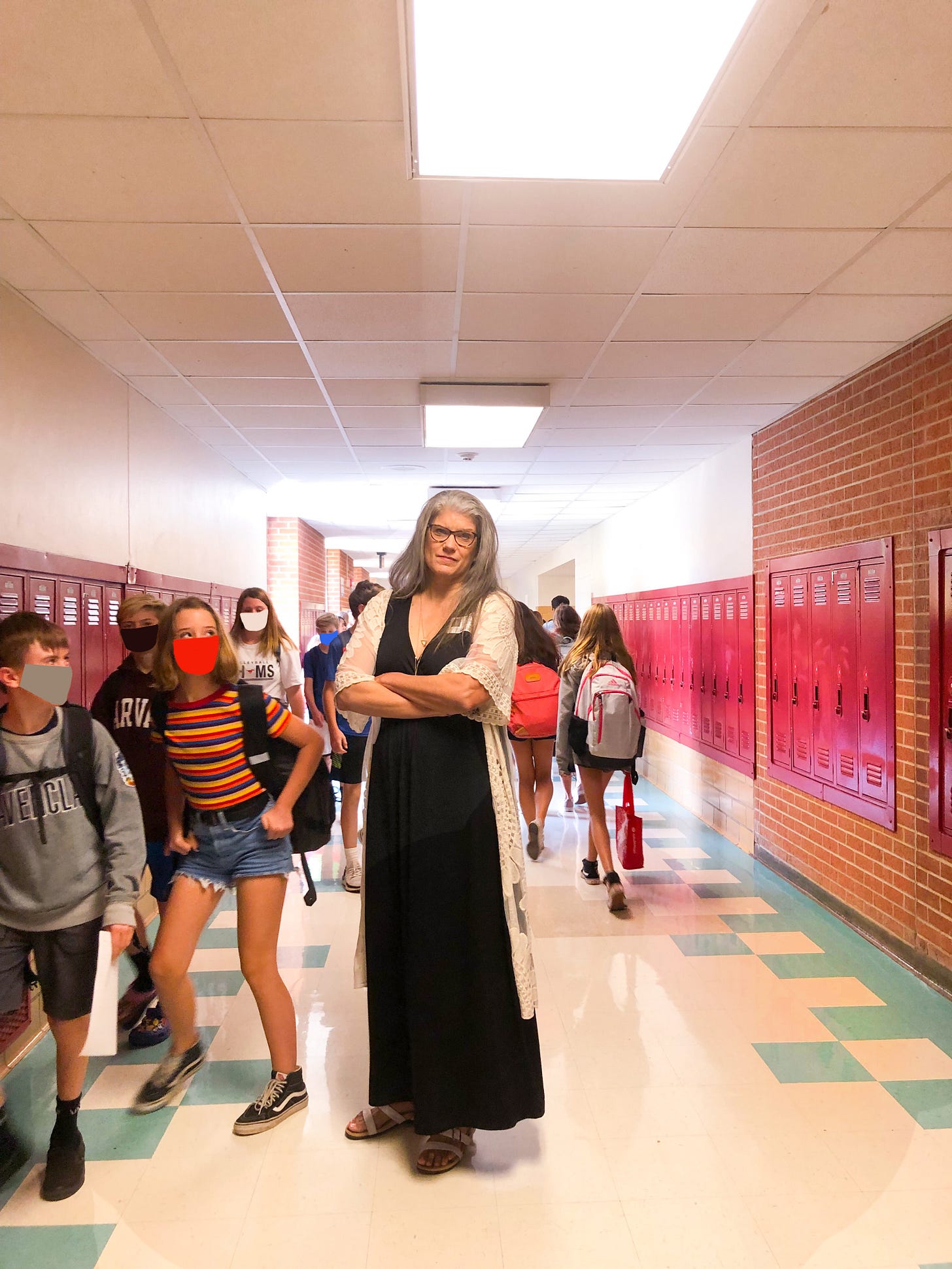This One's For The (Tall) Girls
(or the short boys, or anyone who doesn't measure up to gender height "norms.")
When I was pregnant with my first child I hoped and prayed that if it was a girl, she wouldn’t be taller than six feet. I reached that height—my current height—when I was still in middle school. And I didn’t want my daughter to suffer the agony about her height that I did. By the time I was in seventh grade I was taller than everyone’s mom and all the teachers—even most of the men. Since I couldn’t find any women’s clothes that fit my lumbering frame, I had to buy men’s jeans at the Army Navy store. The closest I could get to ruffles and lace, which is what all the tiny, popular girls wore, was t-shirts with glittered heat-transfers that I got at Highland Mall.
I was both devastated and pissed that I couldn’t express my budding femininity by wearing clothes that made me feel pretty. But in addition to that, at a time when young cis girls want to stick their toes in the water of adolescent romance and flirting, the only boys interested in me were men—most of which were of the “dirty old” variety. Boys my age weren’t even remotely interested in a girl that towered over them. They were too busy wrestling with the cultural notion that their masculinity was dependent on how big they were.
I’ve felt society’s displeasure with my six foot stature for most of my life. When I mention it, people often tell me that it’s all in my head, or that I’m projecting my own insecurities on the culture. And even though I know what I’ve seen and experienced, I’ve often been inclined to discredit myself and agree with them. I just didn’t know many women my height who could corroborate my experiences.
But a couple of years ago I stumbled upon the book, Normal at Any Cost, by Susan Cohen and Christine Cosgrove, and it finally gave me what I’d been looking for: hardcore evidence that gender height biases exist beyond my own experience. The book is mostly an exposé of the Human Growth Hormone (HGH) industry, which fuels what is often called “cosmetic endocrinology.” It involves injecting small or short children with HGH in an effort to bypass their genetic predispositions and make them taller (spoiler alert: most of them are boys.) The book also examines the cultural narratives that have driven these height-altering medical practices. Clearly, ideas about gender height norms were embedded in the social ether long before I was born. And thankfully, Cohen and Cosgrove uncovered evidence of it in several prominent places.
An article in the November 1942 issue of Parents magazine declared tallness a handicap for girls and recommended getting them involved in athletics, as long as they didn’t,
“turn into an Amazon trying to beat the boys at their own games and in this way make up for the fact that she lacks the ability to be normally feminine.”
A decade later, an Australian pediatrician named Norman Wettenhall warned that tall girls would have diminished marriage prospects and may even find it difficult to establish heterosexual relationships. At the time, marriage was still the number one vocational choice for women. And being gay was considered a mental illness (it wasn’t removed from the American Psychological Association’s list of mental disorders until 1973.) So it’s no surprise he found hundreds of parents willing to enroll their daughters in high-dose estrogen trials in an effort to hasten puberty, which closes the growth plates. It often worked, but it also subsequently increased the girls’ risk of cancer, infertility and miscarriage later in life.
In another effort to stunt growth, one doctor from the Mayo Clinic even recommended withholding food from tall girls, giving them only enough nourishment to maintain health. Even though I didn’t hear about any of this until I read the book, I was stunned to realize that I’d grown up in the 1970’s believing those exact things: that I lacked the ability to be normally feminine; that my height would prevent me from finding love; and that if I wanted to be accepted, I needed to starve myself. Like airborne viruses, those narratives had been floating around me for decades. And I had swallowed them whole without even realizing it. I think we all did.
You’d think our deeply rooted ideas about sex and height might’ve waned with the shifts in gender roles over the last 70 years. But some parents are still so worried about having tall girls and short boys they’re putting their kids through ridiculously expensive and dangerous treatments in an attempt to spare them the stigmas. The 2012 indie documentary, Tall Girls: A Story of Giants, follows two budding European girls who are seeking ways to limit their height. Lea, who is 12, learns to inject herself with Sandostatin, which is primarily used to treat adults with cancerous tumors on their pituitary glands. The drug isn’t approved for use in children. Sarah, another 12-year-old, decides to have surgery in order to close the carpal bones in her knees. Supposedly that will keep her 5’ 11” frame from stretching to a predicted 6’ 3.” In an interview, her doctor explains the reasoning behind surgical intervention:
“Obviously, that’s a body size that a girl can’t be happy with,” he says.
More recently, in a November 2019 episode of the NPR podcast This American Life, contributor Scott Brown did a segment entitled “Coming up Short,” where he interviewed a doctor who called the demand for HGH an “epidemic.” I write about the challenges of being a tall woman because I am one. But short men also face an enormous cultural bias because societal notions about gender and height are still rooted in the idea that men should be physically dominant. And for that reason, many are still trying to modify their kids rather than addressing the stigmas.
When I was raising three girls who grew up to be 6’0”, 5’10” and 5’9” I did the only thing I could think of to help them weather the cultural discourse they’d encounter about their size: I tried to hijack the narrative. I told them how lovely they were and how great it was to be tall, even though in many ways I still didn’t feel that way about myself. I figured if they believed me, who cares if it was a case of do-as-I-say-not-as-I-do? I commiserated with them in department store dressing rooms. I offered retorts to strangers who carelessly said things that made them feel like freaks. We were a small clan of large women.
And while none of them liked being so much taller than their peers, I think there was some solace for them in not being the “only one,” (like I was in my family and in my community.) I think tall girls in this day and age have a much better shot at self-acceptance than those of us who grew up in the sixties, seventies and eighties. Thanks to the body positivity movement and celebrities like Gal Gadot and Elizabeth Debicki (5’10” and 6’3”, respectively) who carry their height proudly and wear 3+ inch heels without apology; thanks to the growing number of online retailers who offer longer sleeve and pant lengths, and influencers who have proved that we are legion (and that making extended sizes could actually be lucrative); thanks to the internet, which makes it possible to connect with other tall women across the globe, my grandkids are growing up in a different world than I did.
I recently texted my beautiful 6’1”, 15 year old granddaughter, Haven, to see if she had any reflections on being a tall girl in middle school. She’s now a high school freshman and wears a ladies size 13 shoe.
“Random question” I typed. “On a scale of 1-10, how much did people taunt you about your size when you were in middle school?”
I saw the dots appear so I knew she was answering me.
“Oh, like zero,” she replied.
“REALLY?”
“Yes, it was a virtue.”
“Okay, wait a minute,” I shot back. “Do you mean that it was a virtue to you or a virtue to everyone?”
More dots.
If I were to rate how often I was humiliated about my height when I was in middle school, I’d say it was an eight or nine. Haven’s six-foot mother, Amy, who was a basketball star, says hers was about a seven. She remembers being glad when people followed up “You’re so tall!” with “Do you play basketball?” because they typically seemed relieved when she answered affirmatively. Being an athlete gave her an acceptable reason to be a big girl. Haven is a violinist and has no interest in (or much aptitude for) sports. But she truly seems secure about her size. Part of that, I think, is that the stigma is slowly weakening. But I also attribute it to the fact that her mom has taken every possible opportunity to spin her height as a good thing.
“No, it wasn’t just me,” Haven finally replied. “Everyone thought it was a virtue.”
Of course she has no idea what everyone else was thinking. But if she thinks that they think her height is an asset; and she thinks that her height is an asset, then she’s living in the best story possible: her own. Many of us who were raised in a time when cultural narratives about gender and height remained largely unchallenged are still trying to lose the biases we’ve held against ourselves for decades. We unwittingly stepped into the story that society spun for us, which means we have to work a little harder to get to where Haven is.
In 2019 I had a wild thought: what if I arranged a visit to my middle school so that I could stand in those halls again at the same height I was then, but with the advantage of age and perspective. Did I really stick out as much as I thought I did? Were my peers really that much smaller than I was? I emailed the principal, told her I was writing a book and would love to revisit the school for the sake of jogging my memory. I was surprised when she wrote back and said that would be fine.
When I arrived she greeted me, vetted me and then handed me over to a bubbly eighth grade aide, who was tasked with giving me a tour of the school. On a whim I handed her my phone and asked her to take a pic or two of me standing in the hallway of my middle school. But to my surprise, the bell rang and students flooded the corridors. It didn’t deter my guide one bit; she just kept snapping photos. When I went back through the images I was astounded that she captured a moment that pretty much embodied how I felt as a 13 year old: like a spectacle. For privacy reasons I had to put masks on the students, but their rubbernecking to catch a glimpse of the ultra-tall woman in the hallway wasn’t entirely unlike the looks I remember getting on a daily basis in 1974. As it turns out I was right: being my size in a sea of “normal” sized middle schoolers was exactly as I remembered it. But I must say that standing in the hallway again as an adult—knowing what I know and loving who I am—was pretty damn powerful.






Aw - thanks, Jack. My husband is 6'6" and it took me a while to understand that it wasn't all roses for him, either. Even though most men want to be tallish, nobody wants their height (or anything else about their body) to be the centerpiece of their existence. Our six kids are 6'5", 6'4", 6'1" (<-- his boys) and 6'0", 5'10" and 5'9" (<-- my girls.) It's rare, but when we're all together in public, we are a sight to behold!
I forwarded this piece to my son who is 6'5" and has never been fond of his height. He endured the burden of being the tallest kid in every class.
Despite how you felt about yourself, the Laura I recall from '78 was not only tall, but smart, funny, confident, feminine and stunningly gorgeous. It appears nothing has changed. Keep sharing, you're an excellent photo journalist.